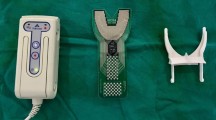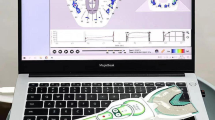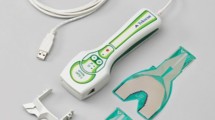Abstract
Background
Superficial clinical examination of occlusion and just assessing the morphologic relationship of teeth at the finishing stages of orthodontic treatment may be insufficient. A case with a clinically satisfying occlusion may be functionally unbalanced. Evaluating occlusion both statically and functionally for uniform distribution of occlusal load is essential for optimum results and therefore, it is imperative to evaluate the occlusal contacts in the vertical plane.
Aims
The aim of the study was to quantitatively assess the occlusion at the pre finishing stage of orthodontic treatment using T Scan in order to identify the various occlusal variabilities and compare it to the occlusion achieved after 1 month of completion of orthodontic treatment.
Methods
Quantitative occlusal analysis using T Scan was performed on 16 adult patients at the start of finishing stage (T1) followed by a detailed finishing and settling phase of 2 months. Another scan was taken 1 month after debonding (T2).
Results
Using Wilcoxon matched pair test, statistically significant changes were seen in mandibular position and occlusal contacts at T2 as compared to T1. Relatively equal distribution of forces on both sides of the arch was also achieved after a detailed finishing and settling phase.
Conclusions
Evaluation of the number and distribution of occlusal contacts at the end of active orthodontic treatment has not been a routine procedure in orthodontic clinics. 2 months of extensive finishing and detailing phase resulted in marked improvement in all three parameters and favorable changes in occlusion. Hence, evaluation of occlusion using T Scan is an innovative and objective method, emphasizing that proper finishing is mandatory for obtaining functionally stable occlusion.






Similar content being viewed by others
References
Haydar B, Ciger S, Saatci P. Occlusal contact changes after the active phase of orthodontic treatment. Am J Orthod Dentofacial Orthop. 1992;102(1):22–8.
Angle EH. Treatment of malocclusion of the teeth and fractures of the maxillae. Angle’s system. Philadelphia: S. S. White Dental Mfg.; 1900.
Andrews LF. The six keys to normal occlusion. Am J Orthod. 1972;62(3):296–309.
Cohen-Levy J, Cohen N. Computerized occlusal analysis in dentofacial orthopedics: indications and clinical use of the T-scan III system. Dentofacial Anom Orthod. 2012;15:203.
Șoaita C, Popșor S. Pre and post orthodontic simulated occlusions. Romanian J Oral Rehabil. 2012;4(4):32–6.
T-scan III User Manual, ver 5.x, Tekscan Inc, Boston, MA.
Venus S, Neeta P, Monika M, Sapna B. Computerised occlusal analysis. Indian J Dent Sci. 2013;5(2):141–4.
Saraçoglu A, Ozpinar B. In vivo and in vitro evaluation of occlusal indicator sensitivity. J Prosthet Dent. 2002;88(5):522–6.
Fleming J, Buschang PH, Kim K, Oliver D. Post treatment occlusal variability among angle classi non extraction patients. Angle Orthod. 2008;78(4):625–30.
An WW, Wang BK, Bai YX. Occlusal contacts in intercuspal position after orthodontic treatment. Am J Dentofacial Orthop. 2009;44(12):735–8.
Razdolsky Y, Sadowsky C, BeGole EA. Occlusal contacts following orthodontic treatment: a follow-up study. Angle Orthod. 1989;59(3):181–5.
Gazit E, Lieberman MA. Occlusal contacts following orthodontic treatment measured by photocclusion technique. Angle Orthod. 1985;55(4):316–20.
Durbin DS, Sadowsky C. Changes in tooth contacts following orthodontic treatment. Am J Orthod Dentofacial Orthop. 1986;90(5):375–82.
Dincer M, Meral O, Tumer N. The investigation of occlusal contacts during the retention period. Angle Orthod. 2003;73:640–6.
Morton S, Pancherz H. Changes in functional occlusion during the post orthodontic retention period: a prospective longitudinal clinical study. Am J Orthod Dentofacial Orthop. 2009;135:310–15.
Riise C. A study of the number of occlusal contacts in the intercuspal position at light and hard pressures in adults. J Oral Rehabil. 1982;9:469–77.
de Freitas KM, Janson G, de Freitas MR, Pinzan A, Henriques JF, Pinzan-Vercelino CR. Influence of the quality of the finished occlusion on post retention occlusal relapse. Am J Orthod Dentofacial Orthop. 2007;132(4):428–34.
Tipton R, Rinchuse DJ, Sassouni V. An evaluation of functional occlusal interferences in orthodontically treated and untreated subjects. Angle Orthod. 1983;53:122–30.
Cohen-Levy J, Cohen N. Occlusal contacts analysis after lingual orthodontic treatment in the adult patient with a computerized system. Int Orthod. 2011;9(4):410–31.
Rebecca P. A method of finishing the occlusion. Am J Othod Dentofacial Orthop. 1999;115:476–87.
Kerstein RB. Articulating paper mark misconceptions and computerized occlusal analysis technology. Dent Implantol Update. 2008;19(6):41–6.
Gokhan O, Munire S, Servet D, Ahmet S, Birgul O. Evaluation of articulation following orthodontic treatment utilizing SamII articulator and T scan occlusal analyser before and after occlusal adjustment. J Med Sci. 2002:115–118.
Lyotard N, Hans M, Nelson S, Valiathan M. Short-term post orthodontic changes in the absence of retention. Angle Orthod. 2010;80(6):1045–50.
Wang YL, Cheng J, Chen YM, Yip KH, Smales RJ, Yin XM. Patterns and forces of occlusal contacts during lateral excursions recorded by the T-Scan II system in young Chinese adults with normal occlusions. J Oral Rehabil. 2011;38(8):571–8.
Trpevska V, Kovacevska G, Benedeti A, Jordanov B. T-SCAN III system diagnostic tool for digital occlusal analysis in orthodontics- a modern approach. J Med Sci. 2014;2:155–60.
Author information
Authors and Affiliations
Corresponding author
Ethics declarations
Conflict of interest
V. Seth, A.K. Patil, H. Kidiyoor, and K. Patil state that there are no conflicts of interest.
All studies on humans described in the present manuscript were carried out with the approval of the responsible ethics committee and in accordance with national law and the Helsinki Declaration of 1975 (in its current, revised form). Informed consent was obtained from all patients included in studies.
Rights and permissions
About this article
Cite this article
Seth, V., Patil, A.K., Kidiyoor, H. et al. T Scan – An aid in achieving stable occlusion during finishing stages of orthodontic treatment. J. Stomat. Occ. Med. 8 (Suppl 1), 30–36 (2016). https://doi.org/10.1007/s12548-016-0144-z
Received:
Accepted:
Published:
Issue Date:
DOI: https://doi.org/10.1007/s12548-016-0144-z




